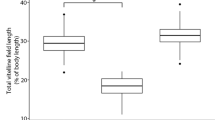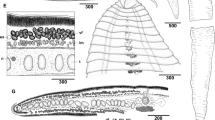Summary
The three previously described Kiricephalus spp. are considered distinct because of differences in the number of abdominal annuli and differences in geographical and host distribution. Observations of a large number of specimens have confirmed the validity, and considerably extended the host list, of the two most common species, K. pattoni (Stephens, 1908), Sambon, 1922 and K. coarctatus (Diesing, 1850), Sambon, 1910. Generally annulus number is a satisfactory and reliable criterion upon which to separate species and three new species are described. One, K. constrictor, has an overlapping geographical distribution and annulus count with K. coarctatus, but comparative hook data reveals that they are unrelated. The life-cycles of the genus, reappraised in the light of the present findings, are shown to involve three vertebrate hosts. Eggs are only infective to amphibians, saurians or mammals, and snakes are second intermediate and definitive hosts, the final infection being acquired through ophiophagy. ac]19790725
Similar content being viewed by others
References
Deakins, D. E. (1971) Pentastomes from Blackbeard Island, Georgia, with notes on North American Pentastomes. Journal of Parasitology, 57, 1197.
Ewers, W. H. (1973) A host-parasite list of the protozoan and helminth parasites of New Guinea animals. International Journal of Parasitology, 3, 89–110.
Fain, A. (1961) Les pentastomides de l'Afrique centrale. Annales de Musée Royal de l'Afrique centrale, Series 8, 92, 1–115.
Faust, E. C. (1927) Linguatulids (order Acarina) from man and other hosts in China. American Journal of Tropical Medicine, 7, 311–325.
Hett, M. L. (1915) On some new pentastomids from the Zoological Society's Gardens. Proceedings of the Zoological Society, 1, 115–121.
Hett, M. L. (1921) On a small collection of pentastomids from the Indian Museum, Calcutta. Records of the Indian Museum. 22, 163–164.
Hett, M. L. (1924). On the family Linguatulidae. Proceedings of the Zoological Society (London), 1, 107–159.
Hett, M. L. (1934) On a collection of Linguatulids (Pentastomida) from Burma with description of a new subgenus. Proceedings of the Zoological Society (London), 2, 425–431.
Heymons, R. (1935) Pentastomida. In: Bronns Klassen und Ordnungen des Tierreiches. Leipzig, 5, 1–268.
Job, T. T. & Cooper, A. R. (1917) Notes on Porocephalus globiocephalus. Journal of Parasitology, 3, 138.
Keegan, H. L. (1943) Observations on the pentastomid Kiricephalus coarctatus (Diesing) Sambon 1910. Transactions of the American Microscopical Society, 62, 194–199.
Keegan, H. L., Toshioka, S., Matsui, T. & Suzuki, H. (1969) On a collection of pentastomids from East and South-east Asia. Japanese Journal of Sanitary Zoology 20, 147–157.
Nicoli, R. M. (1963) Phylogénèse et systématique. Le phylum des Pentastomida. Annales de Parasitologie Humaine et Comparée, 38, 483–516.
Riley, J. & Self, J. T. (1979) On the systematics of the pentastomid genus Porocephalus (Humboldt, 1811) with descriptions of two new species. Systematic Parasitology, 1, 25–42.
Salazar, N. P. (1965) Human pentastomiasis in the Philippines with notes on a Taiwan species. Acta Medica Philippina, 2, 151–152.
Sambon, L. W. (1910) Preliminary notes on three new species of tongue worms (Linguatulidae). Transactions of the Royal Society of Tropical Medicine and Hygiene, 3, 134–154.
Sambon, L. W. (1922) A synopsis of the family Liguatulidae. Journal of Tropical Medicine and Hygiene, 25, 188–206; 391–428.
Self, J. T. (1969) Biological relationships of the Pentastomida: a bibliography on the Pentastomida. Experimental Parasitology, 24, 63–119.
Self, J. T. & Kuntz, R. E. (1957) Pentastomids from African reptiles and mammals and from reptiles of Florida Island, British Solomon Islands (South Pacific). Journal of Parasitology, 43, 194–200.
Self, J. T. & Kuntz, R. E. (1960) Pentastomida from reptiles of Lan-Yü Island (Taiwan) with a description of Raillietiella hebitihamata sp.nov. Journal of Parasitology 46, 885–887.
Self, J. T. & Kuntz, R. E. (1967) Host parasite relationships in some Pentastomida. Journal of Parasitology, 53, 202–206.
Shipley, A. E. (1898) An attempt to revise the family Liguatulidae. Archives de Parasitologie, 1, 52–80.
Shipley, A. E. (1900) A description of the Entozoa collected by Dr Willey during his sojourn in the Western Pacific. In: Zoological Results based on material from New Britain, New Guinea, Loyalty Islands and elsewhere, collecting during the years 1895, 1896 and 1897. Part 5: Cambridge 0 University Press.
Stephens, J. W. W. (1908) Two new human cestodes and a new Liguatulid. Annals of Tropical Medicine and Parasitology, 1, 549–556.
Author information
Authors and Affiliations
Rights and permissions
About this article
Cite this article
Riley, J., Self, J.T. On the systematics and life-cycle of the pentastomid genus Kiricephalus Sambon, 1922 with descriptions of three new species. Syst Parasitol 1, 127–140 (1980). https://doi.org/10.1007/BF00009859
Accepted:
Issue Date:
DOI: https://doi.org/10.1007/BF00009859




